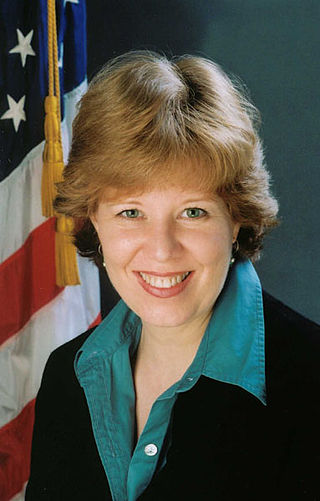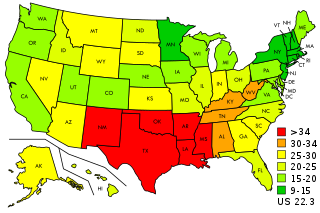Related Research Articles

Emergency contraception (EC) is a birth control measure, used after sexual intercourse to prevent pregnancy.

Teenage pregnancy, also known as adolescent pregnancy, is pregnancy in a female under the age of 20.

Family planning is the consideration of the number of children a person wishes to have, including the choice to have no children, and the age at which they wish to have them. Things that may play a role on family planning decisions include marital situation, career or work considerations, financial situations. If sexually active, family planning may involve the use of contraception and other techniques to control the timing of reproduction.
The Mexico City policy, sometimes referred to by its critics as the global gag rule, is a former United States government policy that blocked U.S. federal funding for non-governmental organizations (NGOs) that provided abortion counseling or referrals, advocated to decriminalize abortion, or expanded abortion services. When in effect, the Mexico City policy is a U.S. government policy that requires foreign non-governmental organizations to certify that they will not "perform or actively promote abortion as a method of family planning" with non-U.S. funds as a condition for receiving U.S. global family planning assistance, and during its January 23, 2017 implementation any other U.S. global health assistance, including U.S. global HIV and maternal and child health (MCH) assistance.
The Planned Parenthood Federation of America, Inc. (PPFA), or simply Planned Parenthood, is an American nonprofit organization that provides reproductive and sexual healthcare and sexual education in the United States and globally. It is a member of the International Planned Parenthood Federation (IPPF).
The Guttmacher Institute is a research and policy NGO that aims to improve sexual health and expand reproductive rights worldwide. The organization was started in 1968 and functions as both a research and educational organization. It operates mainly in the United States but also focuses on developing countries. Founded as part of Planned Parenthood, the Guttmacher Institute became independent from Planned Parenthood in 2007.
Male contraceptives, also known as male birth control, are methods of preventing pregnancy by interrupting the function of sperm. The main forms of male contraception available today are condoms, vasectomy, and withdrawal, which together represented 20% of global contraceptive use in 2019. New forms of male contraception are in clinical and preclinical stages of research and development, but as of 2024, none have reached regulatory approval for widespread use.
Take the Charge is a government program that provides free family planning and pregnancy prevention services to low-income residents of Washington state. The program expands Medicaid coverage for family planning services to individuals whose income is 200% or lower than the federal poverty level (FPL). By reducing the prevalence of unintended pregnancies, the goal of the program is to improve public health while reducing Federal and State Medicaid costs of unplanned pregnancies and their consequences. As of November 2007, there were 200 clinics in Washington providing the program's services.

Susan Orr headed the United States Children's Bureau, a federal agency organized under the United States Department of Health and Human Services' Administration for Children and Families, Administration for Children and Families, as Associate Commissioner.
Contraceptive security is an individual's ability to reliably choose, obtain, and use quality contraceptives for family planning and the prevention of sexually transmitted diseases. The term refers primarily to efforts undertaken in low and middle-income countries to ensure contraceptive availability as an integral part of family planning programs. Even though there is a consistent increase in the use of contraceptives in low, middle, and high-income countries, the actual contraceptive use varies in different regions of the world. The World Health Organization recognizes the importance of contraception and describes all choices regarding family planning as human rights. Subsidized products, particularly condoms and oral contraceptives, may be provided to increase accessibility for low-income people. Measures taken to provide contraceptive security may include strengthening contraceptive supply chains, forming contraceptive security committees, product quality assurance, promoting supportive policy environments, and examining financing options.

Birth control, also known as contraception, anticonception, and fertility control, is the use of methods or devices to prevent unintended pregnancy. Birth control has been used since ancient times, but effective and safe methods of birth control only became available in the 20th century. Planning, making available, and using human birth control is called family planning. Some cultures limit or discourage access to birth control because they consider it to be morally, religiously, or politically undesirable.
The Family Planning Services and Population Research Act of 1970 is the only federal grant program dedicated to providing individuals with comprehensive family planning and related preventive health services. It was signed into law under President Richard Nixon on December 24, 1970.
Unintended pregnancies are pregnancies that are mistimed or unwanted at the time of conception, also known as unplanned pregnancies.

Birth control in the United States is available in many forms. Some of the forms available at drugstores and some retail stores are male condoms, female condoms, sponges, spermicides, over-the-counter progestin-only contraceptive pills, and over-the-counter emergency contraception. Forms available at pharmacies with a doctor's prescription or at doctor's offices are oral contraceptive pills, patches, vaginal rings, diaphragms, shots/injections, cervical caps, implantable rods, and intrauterine devices (IUDs). Sterilization procedures, including tubal ligations and vasectomies, are also performed.
A contraceptive mandate is a government regulation or law that requires health insurers, or employers that provide their employees with health insurance, to cover some contraceptive costs in their health insurance plans.

Globally approximately 45% of those who are married and able to have children use contraception. As of 2007, IUDs were used by about 17% of women of child bearing age in developing countries and 9% in developed countries or more than 180 million women worldwide. Avoiding sex when fertile is used by about 3.6% of women of childbearing age, with usage as high as 20% in areas of South America. As of 2005, 12% of couples are using a male form of contraception with rates of up to 30% in the developed world.

Teenage pregnancy in the United States occurs mostly unintentionally and out of wedlock but has been declining almost continuously since the 1990s. In 2022, the teenage birth rate fell to 13.5 per 1,000 girls aged 15 to 19, the lowest on record. According to the Centers for Disease Control and Prevention (CDC), this decline is due to abstinence and the use of contraception.

Pregnancy options counseling is a form of counseling aimed to counsel women on decision-making for a troubling or unintended pregnancy.

Maternal healthcare in Texas refers to the provision of family planning services, abortion options, pregnancy-related services, and physical and mental well-being care for women during the prenatal and postpartum periods. The provision of maternal health services in each state can prevent and reduce the incidence of maternal morbidity and mortality and fetal death.

International family planning programs aim to provide women around the world, especially in developing countries, with contraceptive and reproductive services that allow them to avoid unintended pregnancies and control their reproductive choices.
References
- ↑ Institute of Medicine (US) Committee on a Comprehensive Review of the HHS Office of Family Planning Title X Program; Stith Butler A, Wright Clayton E, editors. A Review of the HHS Family Planning Program: Mission, Management, and Measurement of Results. Washington (DC): National Academies Press (US); 2009. 2, Overview of Family Planning in the United States. Available from: https://www.ncbi.nlm.nih.gov/books/NBK215219/
- ↑ Cromer, B; McCarthy, Maureen (1999). "Family Planning Services in Adolescent Pregnancy Prevention: The Views of Key Informants In Four Countries". Family Planning Perspectives. 31 (6): 287–93. doi:10.2307/2991539. JSTOR 2991539. PMID 10614519.
- ↑ "US Office of Population Affairs - Legislation". Archived from the original on 2008-09-20. Retrieved 2017-09-09.
- ↑ Sonfield A, Alrich C and Gold RB, Public funding for family planning, sterilization and abortion services, FY 1980–2006, Occasional Report, New York: Guttmacher Institute, 2008, No. 38. http://guttmacher.org/pubs/2008/01/28/or38.pdf
- 1 2 3 4 5 6 Cleland K, Peipert JF, Westhoff C, Spear S, Trussell J (May 2011). "Family planning as a cost-saving preventive health service". N. Engl. J. Med. 364 (18): e37. doi:10.1056/NEJMp1104373. PMID 21506736.
- ↑ "Abortion". Planned Parenthood Federation of America Inc. Retrieved 21 April 2012.
- 1 2 James Trussell; Anjana Lalla; Quan Doan; Eileen Reyes; Lionel Pinto; Joseph Gricar (2009). "Cost effectiveness of contraceptives in the United States". Contraception. 79 (1): 5–14. doi:10.1016/j.contraception.2008.08.003. PMC 3638200 . PMID 19041435.